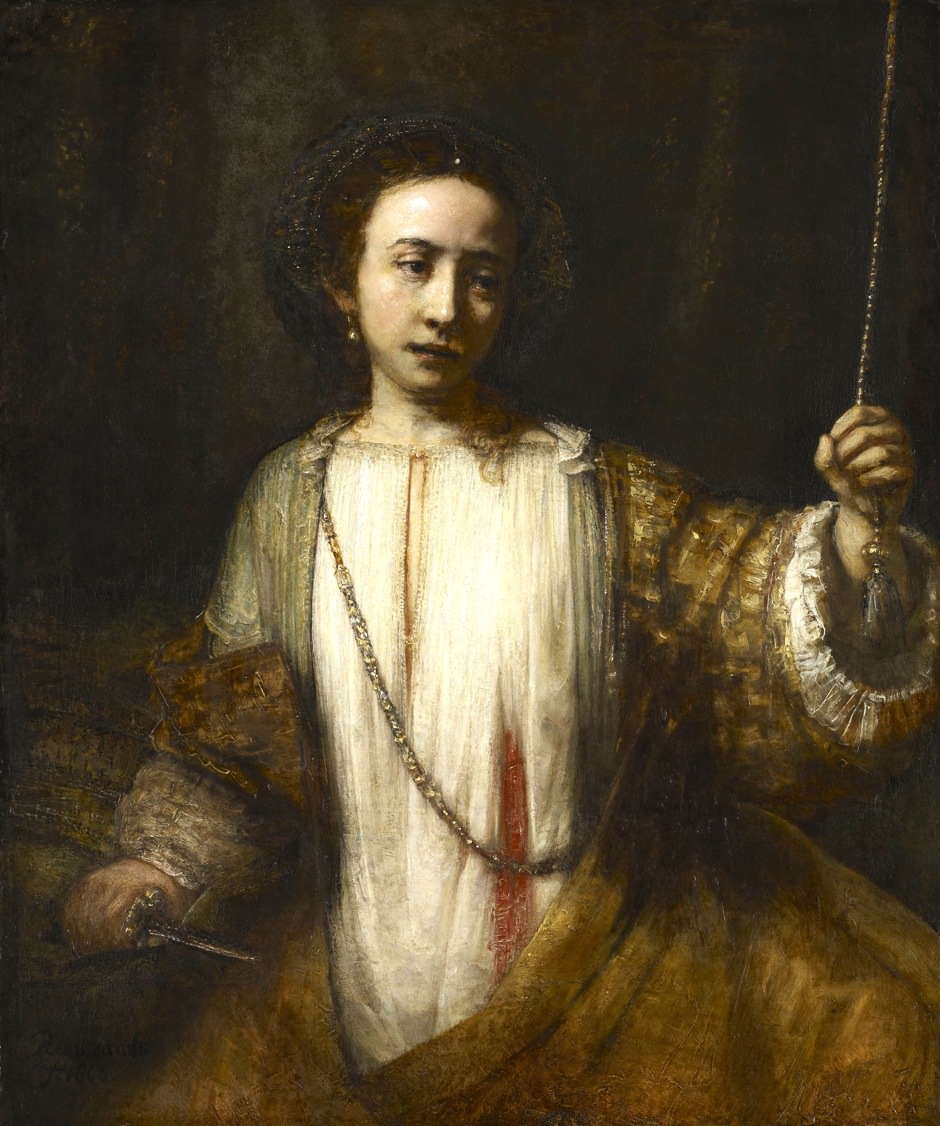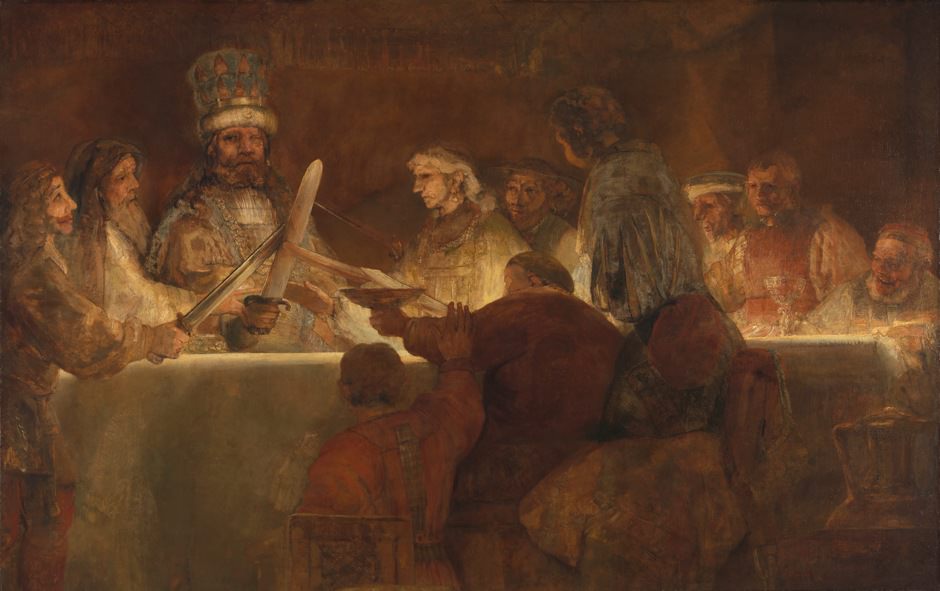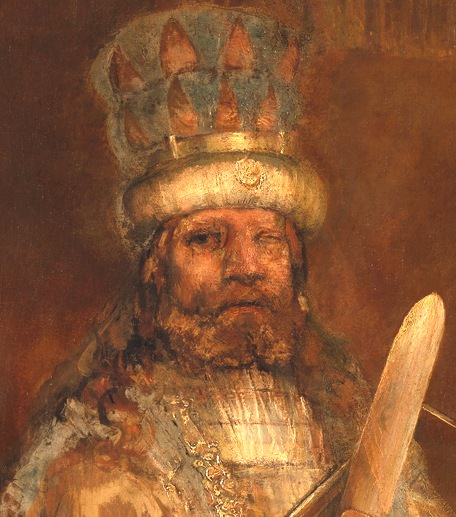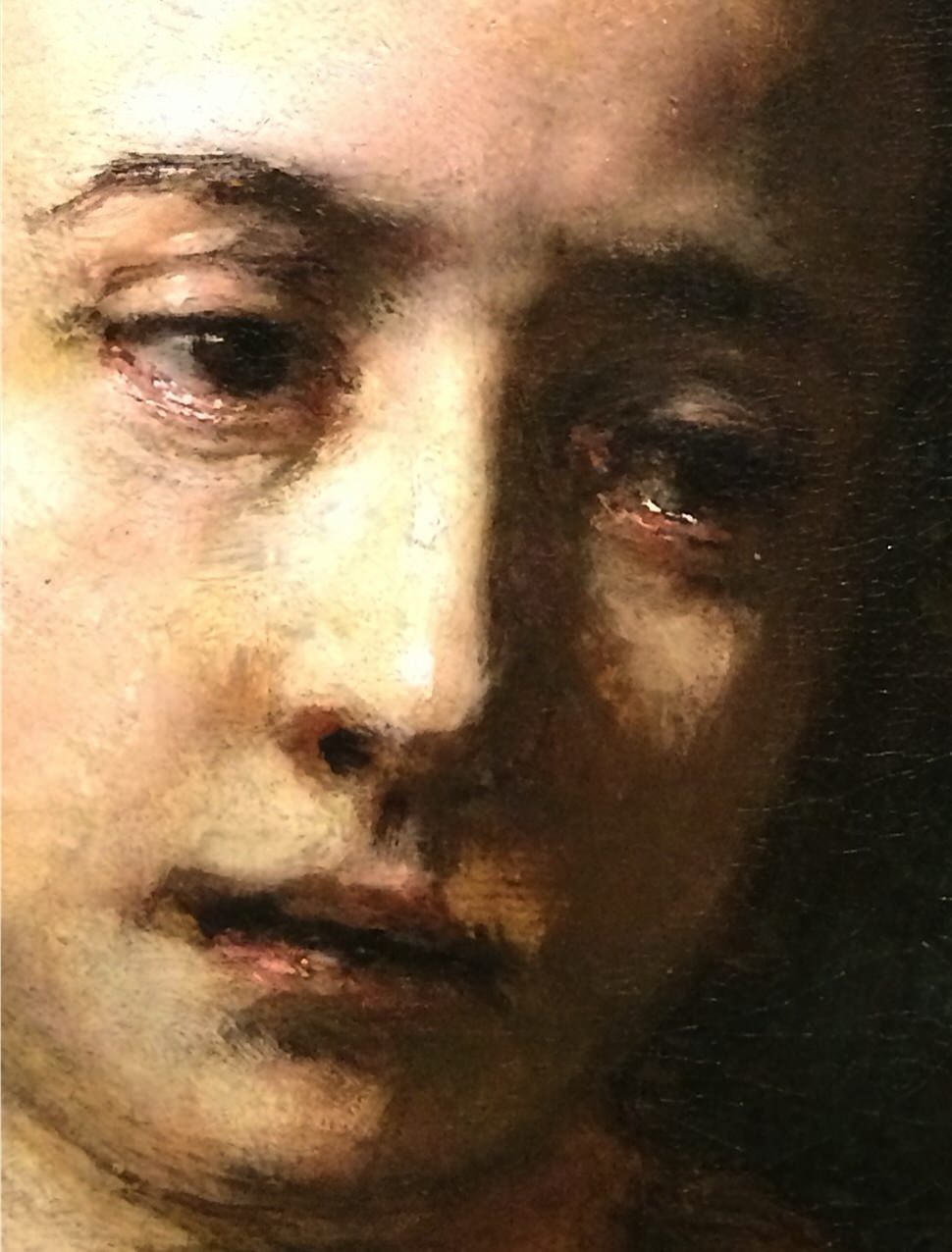“Rembrandt: The Late Works,” an exhibition now on view at London’s National Gallery, will linger long in the mind of anyone who has the pleasure to see it. Bringing together approximately ninety paintings, prints, and drawings Rembrandt made at the end of his life, it reveals a great artist working with unprecedented technical command and emotional power, even as the world closes in around him.
In the fifteen years before his death in 1669, Rembrandt suffered one terrible reversal after another. In 1654, his common-law wife Hendrickje Stoffels was condemned as a whore for her relationship with Rembrandt, and this led some important clients to ostracize him. Ever a spendthrift, he went bankrupt two years later and was forced to auction off his house, art collection, and printing press. Despite such desperate steps, he plunged still further into poverty, becoming so destitute he even had to sell the grave of his first wife, Saskia. Worse still, Hendrickje died of the plague in 1663, and Rembrandt’s beloved son Titus died in 1668, leaving him all but alone.
His prestige as an artist also fell in these years. The dark lighting and rough brushwork of his pictures were deemed unfashionable by many. While still able to attract the occasional attention of major patrons—the Grand Duke of Tuscany Cosimo III de’ Medici visited his studio in 1667—he was now often passed over for major commissions, which frequently went to his former pupils instead.
Yet this time of anxiety, debt, grief, and solitude was the most productive of his career. Despite the decline in his reputation, he made more pictures than ever before, and he painted with increased abandon and inventiveness. It was in these final decades that he created what are now considered many of his greatest paintings, including some of the most renowned images in the history of European art.
As rarely possible before, this exhibition allows the viewer to see many of these late works hanging next to one another. For instance, one gallery features among many treasures two of his most touching images of romantic and sexual love, The Jewish Bride from the Rijksmuseum and A Woman Bathing in a Stream from the National Gallery. Another room displays almost side-by-side two of his most profound studies of the complexity of human feeling, Bathsheba with King David’s Letter from the Louvre and Jacob Blessing the Sons of Joseph from Kassel. Yet another gallery places his greatest group portrait, The Sampling Officials of the Amsterdam Drapers’ Guild, known as The Syndics from the Rijksmuseum among ten of his penetrating portraits of individual sitters. Room after room in the show offers such groupings. The experience of seeing all these works at one time is exhilarating.
The exhibition not only celebrates the familiar triumphs of Rembrandt’s late years; it also brings attention to some pictures that are comparatively, and undeservedly, less well known. One of the most astonishing pictures on view is The Conspiracy of the Batavians under Claudius Civilis from Sweden’s Royal Academy of Fine Arts, which until this year had not left Stockholm since 1969. It was one in a series of pictures for Amsterdam’s Town Hall celebrating the revolt of the Batavians against the Romans, a theme from Tacitus, which the Dutch saw as a heroic precedent for their own recent rebellion against Roman Catholic Spain. The commission of the entire cycle was originally assigned to Rembrandt’s pupil, Govaert Flinck, but following his death in 1660 the project was given to Rembrandt and a group of young artists, almost all former students of his, each receiving one canvas to paint.
Tacitus describes the scene Rembrandt depicted as taking place in a sacred grove “warmed with the festivities of the night.” These words seem to have deeply inspired the artist, for one of the most striking elements of the painting is its dramatic illumination. Smoky golden light cast by an unseen candle or firepot flashes across the tabletop and flickers against the faces of the rebels, whose faces are painted in an extremely loose manner, increasing the impression that one sees them in dancing light. The picture is all the more extraordinary for the extremely limited palette he chose to use: it is painted almost entirely with just three colors, ochre, umber, and sienna.
However, just a few months after its installation in the town hall, Rembrandt was forced to remove the work. Some scholars think his decision to show Claudius Civilis full face, revealing his empty eye socket, may have violated decorum. In any case, he never received the large fee for the painting, which he so desperately needed. Upon getting the picture back, Rembrandt cut it down drastically; nevertheless, the extant painting is the largest picture by the artist to survive.
Advertisement
Another of the great, but less famous, pictures in the show is the Lucretia, painted in 1666, and now in The Minneapolis Institute of Arts. This rapturously beautiful painting exemplifies both Rembrandt’s technical prowess and his newfound depth in the characterization of the figures he portrayed. It depicts the Roman heroine the instant after she has stabbed herself to commit suicide, following her rape by Sextus Tarquinius. She holds the knife with her right hand; her left hand grips the bell-pull with which she is calling her family and servants to come; blood streams down from the wound in her abdomen.
Rembrandt’s freedom in the handling of paint is perhaps what compels the viewer’s admiration first upon studying this picture. Many passages in her glittering mantle and sumptuous chemise were trowelled on thickly with a palette knife, while the highlights on her cuff and elsewhere were painted lightly with the tip of a pinpoint brush. Noteworthy, too, is the range in the thickness of pigment: the shadowed areas on the left side of her face are painted with the thinnest glazes brushed on directly over the preparatory ground layers; yet other areas, such as the chain across her chest, are made of the fattest daubs of impasto. The artist’s facility and control are utterly dazzling.
The longer one looks, however, the more one is mesmerized by the expressive force of the picture rather than its bravura technique. The tears glinting in her eyes, and the black void between her lips give the image an almost unbearable intensity of agony and horror. With few exceptions, most earlier painters had shown Lucretia as a bland emblem of female virtue. No one before had so vividly emphasized her sadness and isolation in death. It has been suggested that Lucretia might be a posthumous portrait of Hendrickje; certainly the image seems to have had a deeply personal meaning for Rembrandt.
His contemporary Sir Thomas Browne wrote in the Religio Medici, “The world that I regard is myself; it is the microcosm of my own frame that I cast mine eye on.” Rembrandt, too, was an artist of obsessive self-regard, especially following the deaths of Hendrickje and Titus. The show opens with a room of five self-portraits, painted between 1659 and 1669, and the effect of seeing them together, with their extraordinary range of mood from pride to self-pity, is unforgettable.
The artist was able to use the knowledge that came from lifelong scrutiny of himself as a way to imagine the temperament and the inner life of others, whether the sitters in his portraits, or the characters in the Biblical and classical stories he depicted. Indeed, Rembrandt is thought to have played out in front of a mirror the expression of the figures he wanted to illustrate in order to be “actor and spectator at the same time,” as one of his pupils wrote. The psychological profundity of many of the pictures in the show seems to stem from an exceptional gift of empathy combined with an extraordinary capacity for the projection of the artist’s own emotions on the subjects he painted.
This is an outstanding exhibition, which anyone interested in art should see. But it is installed in the grim and cramped underground rooms of the National Gallery’s Sainsbury Wing, and never have these poorly designed spaces seemed so antipathetic to the display of great art. In the spring the exhibition will move to the Rijksmuseum and be shown in larger rooms illuminated with natural light. Most likely it will be all the more beautiful and inspiring when viewed in that more congenial setting.
“Rembrandt: The Late Works” is on view at London’s National Gallery until January 18, 2015.







